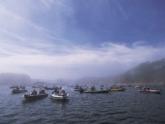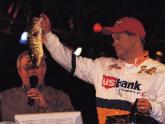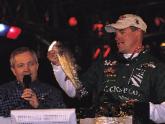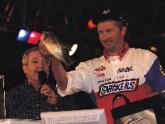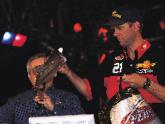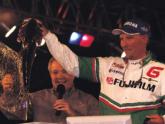Pocket change
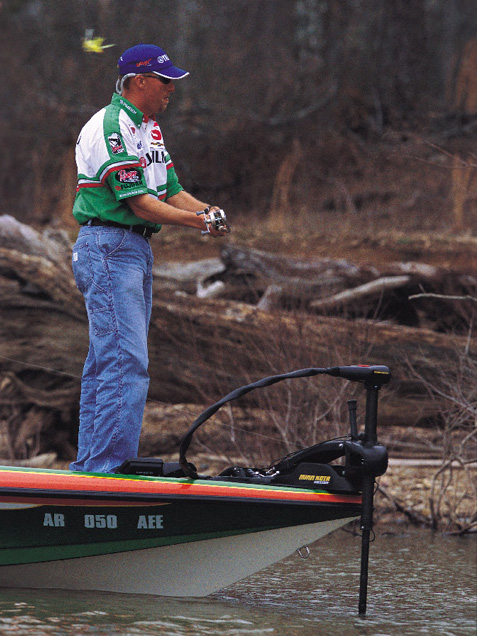
Strader switched from spinning to jigging in his red-hot pocket to ring up $110 grand
From the beginning, the deck was stacked against anglers at the Wal-Mart FLW Tour’s third stop on Lake Ouachita near Hot Springs, Ark. For starters, the minimum length limit for largemouth bass on Lake Ouachita is 16 inches. While anglers reported catching plenty of bass, most did not make the minimum length requirements.
Some anglers figured they could catch one keeper every two hours, meaning they would need a solid eight-hour fishing day to come close to a limit. But Mother Nature put an end to any fishing time calculations when a lengthy fog delay left anglers with only four hours to fish on day one.
Combine a 16-inch size limit with a four-hour fog delay and the result is a weigh-in that saw 78 pros zero and only one five-fish limit. That coveted five-fish limit belonged to Greg Hackney of Oak Ridge, La., the day-one leader.
The fog stayed away for the remainder of the tournament, but anglers still had to contend with the 16-inch size limit.
Lake Ouachita was near normal pool and stable during the course of the tournament. Water temperatures were still in the wintertime range of 45 to 50 degrees. After the fog lifted on day one, sunny skies and calm winds graced the region. The clear skies did not last long, however, as another front approached on day two, and water temperatures remained relatively low due to the lack of sun and cooler nights.
Prevalent patterns
Before the tournament began, there was much speculation about Ouachita’s prolific grass beds. Many predicted that the deep-water grass beds in the lower end of the lake would play a major role in the top qualifiers’ game plans and maybe even provide the winning pattern.
Ironically, it was Ouachita’s upper end that came to life March 13-16 when the FLW Tour came to town. That is not to say that the deep grass was totally unproductive. Kellogg’s pro Jim Tutt of Longview, Texas, Chris Daniels of Clayton, N.C., and Castrol pro David Dudley of Manteo, N.C., all found the grass-bass bonanza on day two and rocketed into the top 20 with stringers in the middle teens.
But the grass fish turned out to be “here today, gone tomorrow,” as Tutt put it. All three anglers bombed on day three when weights started from zero.
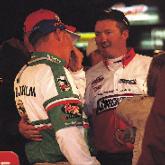 It quickly became clear that Ouachita’s upper end provided the consistency needed to survive the cuts and advance into the finals. Fishing shallow, stained water with fast-moving baits became the prevalent pattern.
It quickly became clear that Ouachita’s upper end provided the consistency needed to survive the cuts and advance into the finals. Fishing shallow, stained water with fast-moving baits became the prevalent pattern.
In fact, Team Fujifilm’s Wesley Strader of Spring City, Tenn., and Craig Powers of Rockwood, Tenn., who finished first and third, respectively, are virtually next-door neighbors in Tennessee, so it is no coincidence that they discovered the same pattern.
“The upper end of this lake looks just like the lakes Wesley and I grew up fishing back home in eastern Tennessee,” Powers said.
Covering massive amounts of water each day was another common thread in the 10 finalists’ strategies. Instead of fishing one area all day, these anglers covered miles of water with fast-moving baits.
Conseco pro Shad Schenck of Waynetown, Ind., estimated he was covering about one mile per hour during practice and competition. Chevy pro Kevin VanDam of Kalamazoo, Mich., who could be considered the world’s fastest bass angler, was burning up the bank as well.
A brutal case of the flu may have been a mixed blessing for Mark Rose at Lake Ouachita. The Marion, Ark., angler said he was so sick that he did not even care if he caught a fish.
Due to his condition, Rose practiced only half a day. He entered the tournament on automatic pilot and caught three fish that put him in 12th place.
“I was just fishing. I wasn’t even trying to evaluate or analyze anything, which may have been a good thing,” Rose said.
For proof that his “flu pattern” was somewhat brainless, Rose reported that he caught one fish on a lipless crankbait, one fish on a jig and one fish on Senko.
Curiously, Rose began to feel much better on day two. He focused his efforts on the inside and outside grass lines in the lower end during the qualification rounds.
“If it was a deep, vertical bank, I fished the inside line,” Rose said. “If it was a flat, shallow bank I fished the outside line.”
With the clouds and wind on day two, Rose stuck with a lipless rattling crankbait.
“I threw a red Strike King Diamond Shad on 12-pound test P-Line,” he said.
After making the top 20, Rose continued covering water with the Diamond Shad. On day three, he began working his way up towards the upper end of the lake.
“I finally decided that good fish were all over the lake and trying to concentrate on one spot was useless,” he said. “Time was better spent just covering water, looking for a good bite.”
By day four, Rose really picked up his fishing pace. He started at the dam and fished all the way back up into the river. His efforts netted three keepers weighing 8 pounds, 5 ounces.
Schenck posted the best finish of his FLW Tour career by fishing shallow in the Ouachita River portion of the lake. He committed to a shallow-water pattern because it was early spring.
“I felt like the shallow water would be more reliable than the deep-water grass, especially if it warmed up at all,” Schenck said.
Late in the practice rounds, Schenck developed a pattern that centered on inside grass lines in pockets of the main river.
“I was fishing inside grass lines in the coves and creeks that had 15 to 18 feet of water coming into them,” he said. “I was concentrating on the secondary points of those grass lines.”
Schenck was covering a lot of water during the course of each day. He was using a red 3/4-ounce Rat-L-Trap tied to 15-pound test Berkley Big Game line.
“The bigger trap would dive down farther than a 1/2-ounce trap, which I think was a key,” he said. “I would slow down on the secondary points, but otherwise I kept the boat and bait moving.”
He almost fell out of contention on day three, however, when the fish in his areas changed.
“My co-angler caught three keepers on a spinner bait up on the shallow laydowns,” Schenck said. “The fish had repositioned, and I missed it. With a warmer day, they had moved up from the inside line to shallow bank cover.”
Schenck managed to catch two keepers on the Rat-L-Trap to grab 10th place going into day four. Overnight the fish pulled back out to the points, and Schenck relied on his Rat-L-Trap again.
“During the nights, the fish were using the points, but later in the day, the fish were scattering back into the pockets and getting on wood,” he said.
After a couple of days of practice, Powers ruled out deep-grass patterns at Ouachita.
“Fishing that deep grass is fine if you have some history on the lake and know where the key locations are,” he said. “But I had never been to Ouachita before, and finding those deep fish is like trying to find a needle in a haystack. So I decided to fish Ouachita just like I fish back home.”
Powers’ plan was to fish as shallow as he possibly could on a lake known for deep water.
“I got as far away from the clear water and grass as I could,” he said.
For Powers, that meant fishing up in the Ouachita River. Powers keyed on shallow flats that had baitfish up on top of the flat. His primary lure was a small, flat-sided homemade crankbait that reaches 4 to 6 feet deep. He was throwing the bait on 8-pound test line so he could get maximum casting distance from the light bait.
Like others that did well in the upper end, Powers was covering tremendous amounts of water each day. Every day he would refish his primary areas, and then he would put the trolling motor down and just start cranking through new water.
VanDam “survived” his way into the finals on Ouachita, catching three bass per day on days one and two and just two bass on day three.
But as VanDam was surviving each day, he was learning more about how the fish were positioning under different conditions. Some conditions favored fishing grass in clear water; other conditions summoned a move into dirtier water where the grass was absent.
“Ouachita is a great pattern lake,” VanDam said. “Once you discover how fish are behaving each day, they become easier to pattern.”
Although VanDam was not filling his limit with keepers each day, he was catching a large number of nonkeepers. He would key off of the nonkeepers’ behavior to establish a pattern.
“A 15 1/2-inch largemouth is just as good as a 16-inch largemouth when evaluating fish behavior,” VanDam said. “I went through a lot of 15 1/2-inch fish that told me how the fish were relating to the conditions.”
VanDam focused his attention on the upper end of Ouachita, where differing water colors were readily available. He fished clear water when it was cloudy and windy and opted for stained water when the sun was bright.
During the four-day tournament, he used a red 1/2-ounce Strike King Diamond Shad lipless crankbait and a handful of homemade flat-sided crankbaits (red), which run 4 to 6 feet deep. He used 10-pound test fishing line.
For VanDam, getting the bait to hit the base of an inside grass line was a key.
“Most guys were fishing over top of the grass, but I was trying to make the Diamond Shad slam into the bottom of the inside grass line,” he said.
VanDam also keyed on laydowns or composition changes that intersected an inside line. He was covering a tremendous amount of water, but by the final day, he learned where to slow down and focus his efforts, depending on the conditions.
“You could fish down the bank on high speed and catch fish, but making repeated casts in certain areas really increased my catch,” he said. “I was keeping my boat and bait in the highest percentage areas for each set of conditions.”
When day four dawned as the coldest morning of the event, VanDam knew what to do.
“During the tournament, fish had been scattering back into the pockets, kind of roaming around, but that cool night pulled them back out to the points,” he said. “One of the first places I stopped I caught 23 bass, three of which were keepers.”
In true VanDam style, he came on strongest during the final round, posting a limit weighing 13 pounds, 5 ounces.
Wesley “Sweets” Strader was given the nickname “Sweet Talk” in middle school because his voice was high and scratchy.
“My basketball buddies called me that because my voice was so soft they said it sounded like sweet talk,” Strader said.
As time went by “Sweet Talk” was shortened to “Sweets.” But Strader’s “sweet talk” turned to elated hoops and hollers that echoed through the Ouachita Mountain valleys when he landed a bass weighing 6 pounds, 10 ounces on the final day of competition.
Like his four closest competitors, Strader was fishing the upper portions of Lake Ouachita. He fished from Crystal Springs up to the No. 27 Bridge.
Strader qualified for the finals by fishing a single lake bluff bank in the Crystal Springs area. His initial catches of 6 pounds, 6 ounces and 9 pounds, 2 ounces came from a narrow band of grass that lined the bluff bank. On day one, he caught one bass on a Bandit Series 200 crankbait and then used a drop-shot rig on the outside grass line (about 20 feet deep) to catch two more. Strader said he moved to the outside line because it was calm and sunny.
On day two, when heavy clouds rolled in, he moved up and began cranking the inside grass line off a bluff in 8 feet of water with the Bandit 200 (red with black stripes) to catch three bass that weighed 9 pounds, 2 ounces.
On day three, the bluff bank bluffed Strader. When the area failed to yield a keeper by noon, he relied on his homegrown fishing skills.
“Back home, when fishing on the main lake gets tough, we always go up the river because there is usually some current, stained water and shallow fish,” he said. “So I just ran up the river and started fishing new water.”
Strader’s Tennessee-trained eyes began scanning the river for flats and “stuff that just looked right.” He was specifically looking for flats that had shallow ditches traversing them and any piece of cover that connected the bank to a ditch.
Strader was working his way upriver late on day three when he found a pocket that particularly excited him.
“This pocket had all the right stuff – a ditch, shallow wood and shad that had blown up into the pocket,” he said. “Best of all, there were bass feeding on the shad.”
Then Strader took a cue from his co-angler for a lure change.
“My co-angler caught three keepers on a spinner bait (white with double willow-leaf blades) before I had a keeper,” he said. “I was born at night, but not last night. So I tied on a white spinner bait and ended up catching three keepers late in the day.”
Strader’s three keepers weighed 6 pounds, 8 ounces, enough to keep him in contention for day four.
When Strader returned to his red-hot pocket to close the deal on day four, things had changed. The shad were not up on the bank and bass were not feeding. He caught a few nonkeepers and was convinced that keeper bass lived in the pocket.
“I adjusted and started flipping a jig on the same laydowns that I had fished with a spinner bait,” he said. “I would swim the jig down the trees. The keeper bass were receptive to the jig.”
Strader caught his tournament-clinching lunker on a jig just before weigh-in. The jig was a 1/2-ounce Lake Fork Tackle Mega-Jig (black and blue) tied to 20-pound test line.
